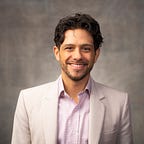Design Challenge — Discovering how to stay out of prison?
My uncles journey rejoining the world after being incarcerated for 30 years (part 2)
About three months ago my uncle was released from prison. After a breakfast at my parents’ house, I was inspired to enter a design challenge…
How might we (my family) support Richie in staying out of prison?
I entered the ‘Discovery’ phase of the human centered design thinking process, which I wrote about in a previous post. I was on a path of exploring my uncle and trying to figure how we could support him to succeed. Along the way, I made a mistake and deviated from the process.
We began by using a tool, a vision map, that we used to define where Richie wanted to go and how to get there. He told me stories of his dreams and frustrations. Along the way I became too focused on ‘finishing the map’ (the output) and less on the journey. We were in the middle of a conversation, he was telling me a story, and I could feel myself pull to bring things back to finish the map and away from hearing the story.
I only realized this after one of our sessions and thought, why was I doing this? I realized I was defaulting to the process I had been taught in school as an engineer, in business as a consultant, and for the most part, in graduate school. It was focused on the scientific method and hypothesis based consulting. After doing this method over and over you get focused on quickly coming to a hypothesis (an educated guess of what you think is the right solution). In this case I hypothesized he ‘needed a vision map’. I then went to complete the task at hand and test if that was what he needed. This was the wrong approach for this problem.
In this instant I learned that what I had been taught was in conflict with the human centered design thinking process. After my start-up experience, the Human Centered Design for Social Innovation class, and my time at the Doblin group it finally made sense. I was not evaluating if something was supposed to work, but instead I was supposed to be observing, exploring, and generating insights that are to be evaluated later all together. Tools, such as the vision map, are important to use, but as a means of gathering data to generate insights.
The design thinking process is different. Evaluation is supposed to come later in the process after ideating. It is more open ended and meant to be used when you want dramatically different answers. In this case Richie had been in and out of prison for 30 years, and yes things were different, but the outcome needed to be about what he needs to succeed, not about what we think he needed to do.
When figuring out something new and creating the future, I needed to embark on a journey of discovering my end destination.
In other words, I need to be comfortable with learning from the journey, exploring, and sometimes getting lost. So that is what I did. I made time to learn. I spent a ‘day with Richie’ and he was more than happy to have me.
We slept in the same room, went with him to his counseling session and an interview, and got lunch with him.
So what were some of my insights?
Here are a few patterns that started to appear from my observations and his stories.
- There is a lot of waiting everywhere; for work, for counseling sessions, for his interview… (no wonder participants in these programs get frustrated)
- He collects lots of pictures
- He has little privacy so when he needs it he disappears (dramatic difference from prison)
- He loves quotes he can recite
- Accomplishments motivate him and he loves to share them with us
Potential Concept Opportunity Areas (in how might we form):
- How might we providing privacy for ex-convicts when they need it?
- How might we provide visual reminders for prisoners to stay focused?
- How might we communicate the change in social values from prison to the outside world?
- How might we provide prisoners an easy method to reach out for help?
I was happy to spend more time with Richie. My next steps are to interview some of his friends that have successfully reentered society and see if more patterns arise.
An update on Richie: He has been working part-time, is interviewing for full-time jobs, and is soon coming up on his four month milestone, the longest period he has been out of jail since he was first admitted! Feel free to leave him a note. He appreciated the last messages of encouragement.
